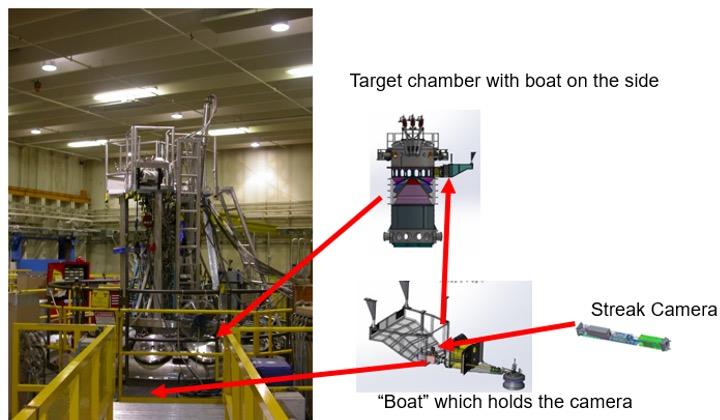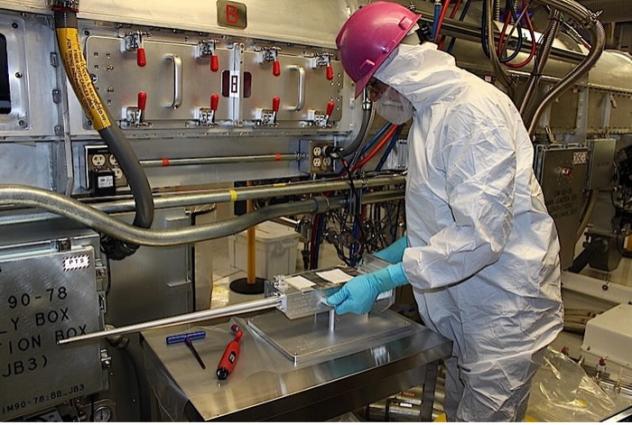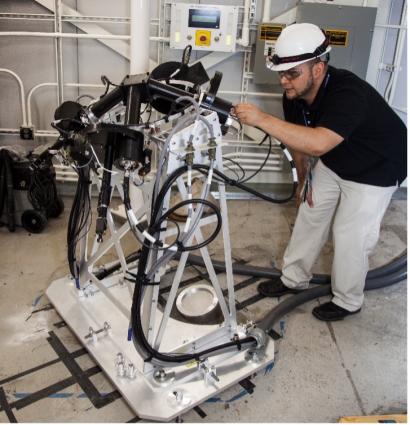
Streak camera radial implementation at Z machine will be used for laser performance verification experiments.
Lawrence Livermore National Laboratory (LLNL) and Sandia National Laboratories continue to collaborate on diagnostic advancements on the nation's premier high-energy density (HED) facilities.
Mark Bowers, magnetic direct drive diagnostics manager at the National Ignition Facility (NIF), said current projects include providing NIF's X-ray streak camera, neutron Time-of-Flight (nToF), neutron imager system (NIS) and other future projects. Sandia's Z facility already has versions of nToF and 1D neutron imaging, but not with the resolution of the NIF diagnostics, Bowers said.
"Each diagnostic is working as a separate project with the management for each assuring that issues in common will be done together," Bowers said. "All of the projects are using proven systems engineering practices, obtaining requirements and constraints before doing the detailed design work."
Bowers explains that there are many differences between the Z machine and NIF, such as timing, target position and size. Therefore new solutions are required for these issues that will be new to both Z machine and NIF.
"Many LLNL experimentalists do experiments at the Z machine," he said. "These diagnostics are required for their work. We are leveraging the transfer of the technology to enable experiments that they require but have not been able to do previously."
There are many engineering challenges that need to be addressed when developing diagnostics at Z. This includes extreme shocks of more than 20G experienced on every experiment, multi-million-electron-volt (MeV) X-ray backgrounds generated, sensitive diagnostic components placed just above the pulsed power components and requiring EMI to be accounted for. In addition, debris ejected from the target region can impact and damage sensitive diagnostic components (able to penetrate 15 centimeters of stainless steel at two meters).
One of the latest collaborations is to bring key stagnation diagnostics to Z.
"There are well-established diagnostic capabilities demonstrated at NIF that are used to make quantitative measurements on inertial confinement fusion (ICF) plasmas," said Michael Jones, chief diagnostic scientist at Sandia. "With these demonstrated capabilities, it is transformational to bring the measurement to maturity for characterizing magnetic direct drive fusion plasmas on Z up to the long-standing ability of NIF. These diagnostic systems are key in addressing measurement gaps in both ICF and assessment science mission space."
Keith LeChien, program group leader for Magnetic High-Energy Density Physics, said LLNL's Weapons and Complex Integration (WCI) organization has been transferring diagnostics to Z for more than 10 years. He said WCI has been doing experiments at Z for 20 years and conducts roughly one-third of all ICF experiments conducted at the Z Facility.
"The diagnostics under development as part of the technology transfer effort will transform our understanding of high-pressure plasmas on the Z Facility and are important in determining the requirements for ignition and high yield on a future pulsed power driver," LeChien said.
Technology transfer projects
The X-ray streak camera is used for laser performance verification experiments as well as a wide range of physics experiments in the areas of HED science, ICF and basic science. The X-ray streak camera system was designed to record time-dependent X-ray emission from NIF targets using an interchangeable family of snouts for measurements such as one-dimensional spatial imaging or spectroscopy.
At Z, it will be similar to SPIDER (Streaked Polar Instrumentation for Diagnosing Energetic Radiation) for phase 1, enabling fast X-ray burn history measurement. Phase 2 will be 1D streaked imaging and phase 3 will focus on streaked spectroscopy.
"Understanding stagnation conditions is greatly enhanced through an analysis based on both X-ray and nuclear signatures," Jones said. "One gap in the X-ray diagnostic suite at the Z facility is the lack of X-ray streak camera-based instruments. At NIF, X-ray streak cameras are regularly used to provide high temporal resolution X-ray burn history measurements (SPIDER), high temporal resolution 1D images of implosions (DISC, or DIM Insertable Streak Camera) and high temporal and spatial resolution spectroscopy measurements (DISC/tConSpec)."
The nTOF system measures the time-of-flight of neutrons emitted from the target. The arrival time at the detector provides the neutron energy, and the spread of arrival times is related to the ion temperature.
Jones discussed the improved nToF for reliable ion temperature (Tion) and kinetic energy: During the latter stages of the National Ignition Campaign (NIC), it became clear that a significant amount of residual kinetic energy (RKE) was present during the burn phase of the implosion. This RKE manifested itself in significantly shifted and broadened neutron time-of-flight signals.
Quantifying the RKE requires measuring the nTOF signals along multiple independent nTOF lines of sight to fully disambiguate coherent and incoherent flow, as well as the true burn weighted Tion.
The NIS uses a precisely aligned set of apertures near the target to form the neutron images on a segmented scintillator. The images are recorded on a gated, intensified charge coupled device. Although the aperture set may be as close as 20 centimeters to the target, the imaging camera system is placed at a distance of 28 meters from the target.
During the NIC, Sandia led the development of three diagnostic capabilities onto NIF: SPIDER, RAGS and NAD20. Through the National Diagnostic Working Group other transformational diagnostic capabilities have been developed for each lab. The two labs worked to bring a Wolter Imaging Diagnostic to Z and Sandia continues to provide hCMOS sensors that are used in several NIF diagnostics.
Another notable partnership between LLNL and Sandia was the Line Velocity Interferometer System for Any Reflector (VISAR) project that began in 2015 and commissioned in 2018, which transferred the VISAR technology to the Z facility. This effort was awarded a National Nuclear Security Administration Defense Programs Award of Excellence.
According to Bowers, the strong relationship between LLNL and Sandia is required for these projects to work. LLNL experimentalists are learning a lot about how Z works and its constraints, while at the same time Sandia employees are learning a lot about NIF and how to leverage NIF technology for Sandia and what technologies are not amenable for transfer.
"Although COVID-19 has caused several issues with the collaboration, the positive side is that both teams work now on Webex for all of the design work," Bowers said. "Because of the new telecommuting mentality, the two teams have become integrated better as one team. The Sandia and Livermore teams are working as one team."








